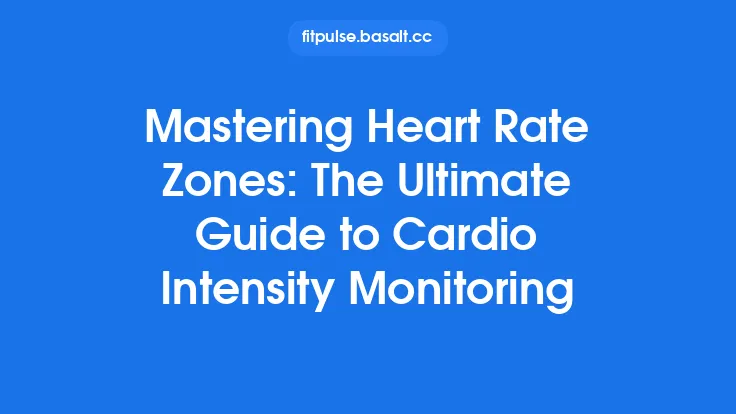When it comes to staying active and competitive later in life, the most reliable compass for guiding effort is the heart itself. By training within specific heart‑rate zones, senior athletes can tailor each workout to match their current fitness level, health status, and performance goals. This approach offers a clear, quantifiable way to improve cardiovascular endurance, manage fatigue, and track progress over months and years—without the guesswork that often accompanies “how hard should I be working?” Below is a step‑by‑step guide that walks you through the science, the calculations, and the practical application of heart‑rate zone training for athletes over 50.
Understanding Heart‑Rate Zones
Heart‑rate zones are ranges of beats per minute (bpm) that correspond to different levels of physiological stress. Each zone reflects a distinct balance between aerobic and anaerobic energy systems, and training within a given zone produces predictable adaptations:
| Zone | Approx. % of Max HR | Primary Energy System | Typical Sensations | Training Benefits |
|---|---|---|---|---|
| Zone 1 – Recovery | 50‑60% | Low‑intensity aerobic | Very easy, can hold a conversation effortlessly | Enhances blood flow, promotes recovery, builds a base for longer sessions |
| Zone 2 – Endurance | 60‑70% | Fat‑oxidation dominant aerobic | Comfortable, steady breathing, can talk in full sentences | Improves mitochondrial density, increases aerobic efficiency |
| Zone 3 – Tempo | 70‑80% | Mixed aerobic/anaerobic | Slightly labored speech, moderate effort | Boosts lactate threshold, raises sustainable speed |
| Zone 4 – Threshold | 80‑90% | Predominantly anaerobic | Hard to talk, breathing noticeably heavy | Increases VO₂ max, improves high‑intensity endurance |
| Zone 5 – VO₂ Max / Sprint | 90‑100% | Maximal anaerobic | Very hard, speaking limited to single words | Enhances maximal oxygen uptake, develops speed and power |
For seniors, the emphasis is typically on Zones 1‑3, with occasional, carefully monitored forays into Zone 4 for performance gains. Zone 5 is generally reserved for highly trained individuals who have cleared medical clearance and possess a solid aerobic foundation.
Why Heart‑Rate Training Matters for Seniors
- Objective Feedback – Unlike perceived effort alone, heart‑rate data provides a concrete metric that can be tracked over weeks and months.
- Safety – Staying within prescribed zones helps avoid excessive cardiovascular strain, which is especially important for those with hypertension, arrhythmias, or other age‑related conditions.
- Efficiency – Targeted zone work maximizes training effect while minimizing time spent in low‑yield intensity ranges.
- Progress Monitoring – Improvements in resting heart rate, recovery heart rate, and the ability to sustain higher zones at the same perceived effort are clear indicators of fitness gains.
Calculating Your Personal Zones
1. Determine Maximum Heart Rate (HRmax)
The classic “220 – age” formula is a convenient starting point, but it tends to overestimate HRmax for older adults. More accurate alternatives include:
- Tanaka Formula:
`HRmax = 208 – (0.7 × age)`
- Gellish Formula (for ages 30‑80):
`HRmax = 207 – (0.7 × age)`
Example: A 65‑year‑old athlete:
- Tanaka: 208 – (0.7 × 65) = 208 – 45.5 ≈ 162.5 bpm
- Gellish: 207 – (0.7 × 65) = 207 – 45.5 ≈ 161.5 bpm
Both give a similar result; you may choose the one you feel most comfortable with.
2. Establish Resting Heart Rate (RHR)
Measure your pulse first thing in the morning, before getting out of bed, for three consecutive days. Average the values.
Example: RHR = 62 bpm
3. Use the Karvonen (Heart‑Rate Reserve) Method
The Karvonen method accounts for individual fitness by incorporating the heart‑rate reserve (HRR = HRmax – RHR).
Formula:
`Target HR = ((HRmax – RHR) × %Intensity) + RHR`
Calculating Zone 2 (60‑70% intensity) for the 65‑year‑old:
- HRR = 162 – 62 = 100 bpm
- Lower bound (60%): ((100 × 0.60) + 62) = 122 bpm
- Upper bound (70%): ((100 × 0.70) + 62) = 132 bpm
Thus, Zone 2 for this athlete is 122‑132 bpm.
Repeat the calculation for each zone using the appropriate intensity percentages (see the table above). Record the resulting ranges in a notebook or on a simple chart you can reference before each workout.
Choosing the Right Zones for Different Goals
| Goal | Recommended Primary Zones | Sample Session Structure |
|---|---|---|
| General Health & Longevity | 1‑2 (70‑80% weekly time) | 30 min walk at Zone 1, 20 min easy bike at Zone 2 |
| Weight Management | 2‑3 (60‑70% weekly time) | 45 min steady jog staying in Zone 2, 10 min cool‑down in Zone 1 |
| Improving Endurance for Competition | 2‑3 (50‑60% weekly time) + occasional Zone 4 | 2 × 60 min runs in Zone 2, 1 × 30 min tempo run in Zone 3, 1 × 20 min interval at Zone 4 (once per month) |
| Increasing Speed / Power | 4 (≤10% weekly time) | 5 × 2‑minute high‑intensity intervals at Zone 4 with 3‑minute recovery in Zone 1 |
| Recovery from Illness or Injury | 1 (100% weekly time) | Gentle pool walking or stationary bike at Zone 1 for 20‑30 min daily |
The key is to align the proportion of time spent in each zone with the specific outcome you are targeting, while respecting overall health constraints.
Designing a Weekly Heart‑Rate Zone Plan
Below is a sample 7‑day schedule for a moderately active senior athlete aiming to improve aerobic endurance while maintaining safety.
| Day | Activity | Duration | Target Zone(s) | Notes |
|---|---|---|---|---|
| Monday | Brisk walk or easy jog | 40 min | Zone 2 | Warm‑up 5 min in Zone 1, main set Zone 2, cool‑down 5 min Zone 1 |
| Tuesday | Rest or gentle stretching | — | — | Active recovery; keep heart rate below 90 bpm |
| Wednesday | Cycling (flat terrain) | 45 min | Zone 2‑3 (first 30 min Zone 2, last 15 min Zone 3) | Gradual progression; monitor breathing |
| Thursday | Strength‑focused walk (incline) | 30 min | Zone 3 | Slightly higher intensity; keep effort sustainable |
| Friday | Rest or light yoga | — | — | Emphasize flexibility without cardiovascular load |
| Saturday | Interval session (run/walk) | 30 min total | 4 × 3 min Zone 4 with 3 min Zone 1 recovery | Warm‑up 10 min Zone 1, cool‑down 5 min Zone 1 |
| Sunday | Long, easy activity (hike, swim) | 60 min | Zone 1‑2 | Enjoyable pace; focus on time on feet rather than speed |
Adjust the total weekly volume based on personal schedule, recovery ability, and any medical advice. The plan can be repeated for 4‑6 weeks before reassessing zones.
Monitoring and Adjusting Your Effort
- Manual Pulse Checks – Every 5‑10 minutes during a session, stop briefly, place two fingers on the radial artery, and count beats for 15 seconds, then multiply by 4. This method requires no technology and reinforces body awareness.
- Talk Test – While not a precise measurement, the ability to speak in full sentences aligns closely with Zone 2, whereas speaking only a few words indicates Zone 4. Use it as a quick sanity check.
- Perceived Exertion Scale (RPE 6‑20) – Match your RPE to the target zone (e.g., RPE 12‑13 for Zone 2). Over time, you’ll notice that the same RPE corresponds to a lower heart‑rate as fitness improves.
- Re‑calculate Every 4‑6 Weeks – As your cardiovascular system adapts, HRmax may shift slightly, and resting heart rate often drops. Re‑measure RHR and, if possible, perform a sub‑maximal test (e.g., a 3‑minute step test) to refine HRmax estimates.
Common Pitfalls and How to Avoid Them
| Pitfall | Why It Happens | Solution |
|---|---|---|
| Staying Too Long in Low Zones | Desire for “easy” workouts, fear of overexertion | Schedule at least one moderate‑intensity session per week; use a timer to ensure you progress beyond Zone 1. |
| Skipping Warm‑Up/ Cool‑Down | Rushing due to time constraints | Treat the first and last 5‑10 minutes as non‑negotiable; they protect the heart and improve HR recovery. |
| Relying Solely on Age‑Based HRmax | Convenience, but can be inaccurate | Use the Karvonen method with a measured RHR; consider a supervised maximal test if medically cleared. |
| Ignoring Symptoms | “I feel fine” despite high heart rate | Stop immediately if you experience chest discomfort, dizziness, or unusual shortness of breath; consult a healthcare professional. |
| Over‑emphasizing High‑Intensity Work | Wanting quick gains | Keep Zone 4 sessions to ≤10% of weekly training volume; prioritize consistency in Zones 1‑3. |
Safety Considerations and Medical Clearance
- Pre‑Exercise Screening – Before beginning any structured heart‑rate zone program, obtain clearance from a physician, especially if you have a history of cardiovascular disease, hypertension, arrhythmias, or are on medications that affect heart rate (e.g., beta‑blockers).
- Medication Adjustments – Some drugs blunt heart‑rate response, making zone calculations less reliable. In such cases, rely more heavily on perceived exertion and the talk test.
- Hydration & Temperature – Exercise in moderate climates; avoid extreme heat or cold, which can artificially raise or lower heart rate.
- Emergency Plan – Keep a phone nearby, know the location of the nearest medical facility, and have a brief emergency action plan in case of sudden cardiac symptoms.
Integrating Heart‑Rate Training with Other Aspects of Fitness
While this guide focuses on cardiovascular zones, a well‑rounded senior training program also includes:
- Mobility Work – Light dynamic stretches before sessions to maintain joint range of motion.
- Strength Maintenance – Two weekly sessions of resistance work (bodyweight, resistance bands, or light free weights) to support cardiovascular performance and protect against falls.
- Balance Drills – Simple single‑leg stands or tandem walking to complement endurance training.
These components do not conflict with heart‑rate zone training; rather, they enhance overall functional capacity, allowing you to stay in the desired zones longer and with better form.
Practical Tips for Long‑Term Success
- Keep a Training Log – Record date, activity, duration, start/stop heart rates, and RPE. Review monthly to spot trends.
- Set Incremental Goals – Aim to increase the time spent in Zone 2 by 5 minutes every two weeks, or to lower your Zone 2 heart‑rate by 2‑3 bpm after a month of consistent training.
- Use Simple Tools – A basic digital timer, a printed zone chart, and a pulse‑checking guide are all you need; sophisticated gadgets are optional.
- Stay Social – Join a walking club or a senior cycling group. Group settings provide motivation and make zone monitoring a shared activity.
- Celebrate Milestones – Whether it’s completing a 10‑km walk in Zone 2 or noticing a lower resting heart rate, acknowledging progress reinforces adherence.
By understanding the science behind heart‑rate zones, calculating personalized ranges, and applying them thoughtfully to weekly training, senior athletes can enjoy safer, more effective workouts that support longevity, competitive performance, and overall well‑being. The heart is a reliable guide—listen to its rhythm, respect its limits, and let it lead you toward a healthier, more active later life.




